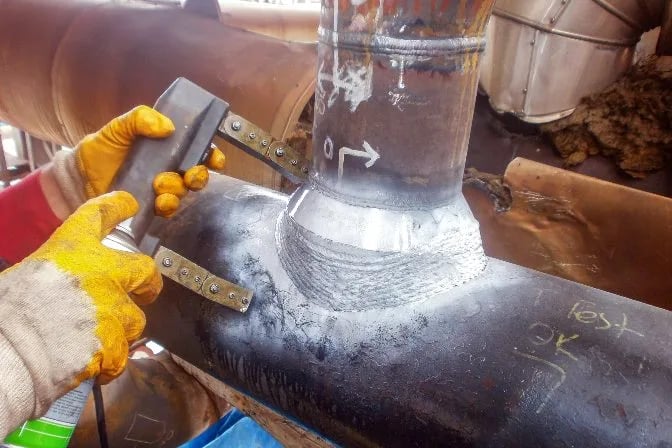Comprehensive Overview of Pipe Welding Evaluation Procedures
Pipe welding examination procedures play an essential role in guaranteeing that bonded connections meet rigorous market standards and requirements. From precise pre-welding evaluations to comprehensive post-weld evaluations, a well-defined examination procedure is important for keeping the architectural stability of pipes.
Pre-welding Evaluation Preparations
Prior to beginning the welding procedure, complete pre-welding inspection prep work are necessary to make certain the integrity and top quality of the weld joint. These preparations involve a precise exam of the materials to be bonded, the welding equipment, and the job environment. The materials should be inspected for any type of defects, pollutants, or incongruities that might jeopardize the weld. This includes checking for proper product qualities, dimensions, and surface problems. Pipeline Welding Inspection. In addition, the welding tools needs to be examined to confirm that it remains in excellent functioning condition, calibrated properly, and appropriate for the details welding procedure. Any issues with the devices must be resolved promptly to avoid flaws in the weld. Last but not least, the job atmosphere have to be evaluated for cleanliness, proper ventilation, and precaution to ensure a helpful setup for the welding procedure. By conducting extensive pre-welding assessment preparations, potential issues can be recognized and settled beforehand, causing trusted and high-grade weld joints.
Welding Procedure Credentials
Comprehensive pre-welding examination preparations lay the structure for the important process of Welding Treatment Qualification, making sure the integrity and top quality of the weld joint. Welding Procedure Certification (WPQ) is an important action in the welding process that includes screening and certifying welding treatments to guarantee they fulfill particular criteria and demands. The WPQ process commonly consists of welding procedure requirements advancement, welding procedure certification testing, and documents of the results.
Throughout welding procedure requirements advancement, vital information such as the welding procedure, welding materials, joint style, and welding criteria are specified to create an extensive treatment. Ultimately, welding treatment qualification testing is carried out to verify the recommended treatment's honesty. This testing typically includes welding examination discount coupons that go through numerous mechanical and non-destructive examinations to analyze the weld's quality and adherence to the specified requirements.
In-process Weld Assessment
Throughout the welding procedure, in-process weld assessment plays an essential function in making certain the quality and integrity of the weld joint - Pipeline Welding Inspection. This type of evaluation includes keeping an eye on the welding criteria, analyzing the weld grain formation, and detecting any possible flaws or discontinuities as they happen. By carrying out in-process weld evaluations, welding operators can quickly address any concerns that might develop, consequently stopping additional defects anonymous and ensuring that the final weld meets the called for requirements
Common techniques used for in-process weld examination include visual examination, liquid penetrant screening, magnetic particle testing, ultrasonic screening, and radiographic testing. On the whole, in-process weld evaluation is crucial for maintaining the top quality and reliability of bonded pipes.
Non-destructive Screening (NDT)
Non-destructive Testing (NDT) is an essential approach used in pipe welding inspection to analyze the integrity of weld joints without causing damage to the bonded framework. By making use of various NDT techniques, examiners can examine the top quality of welds and recognize any kind of defects or interruptions that might endanger the architectural soundness of the pipeline. Common NDT methods used in pipeline welding evaluation include Radiographic Testing (RT), Ultrasonic Testing (UT), Magnetic Bit Checking (MPT), Fluid Penetrant Screening (LPT), and Visual Testing (VT)
RT includes making use of X-rays or gamma rays to create pictures of the inner framework of the weld, enabling examiners to find issues such as porosity, splits, or insufficient blend. UT makes use of high-frequency acoustic waves to identify flaws beneath the surface area of the weld, using in-depth info regarding the size and location of issues. MPT and LPT are made use of to determine surface-breaking problems by applying penetrant fluids or magnetic bits to the weld area. In addition, VT entails aesthetic evaluation of welds to identify any kind of noticeable imperfections.
Post-weld Inspection and Documentation

Documents of post-weld evaluation findings is crucial for preserving quality control documents and making sure compliance with sector requirements and guidelines. Comprehensive records should consist of info about the examination methods made use of, the place and nature of any type of issues located, and any corrective actions taken - Pipeline Welding Inspection. Correct documentation not only functions as a record of the weld's high quality yet also aids in future upkeep and inspection processes
Verdict

Finally, pipeline welding examination procedures play a critical role in making sure the my sources quality and stability of welds. From pre-welding examinations to post-weld documentation, each step is essential in preserving the security and efficiency of pipelines. By following well-known procedures and performing extensive inspections, possible problems can be recognized and dealt with prior to they lead to expensive repairs or failures. Generally, adherence to proper assessment protocols is vital to the success of pipe welding tasks.
From meticulous pre-welding inspections to comprehensive post-weld assessments, a well-defined inspection procedure is crucial for keeping the architectural sturdiness of pipes. By performing in-process weld examinations, welding drivers can immediately attend to any type of concerns that might develop, therefore preventing more issues and ensuring that the last weld satisfies the called for requirements.
Common techniques made use of for in-process weld evaluation consist of visual inspection, liquid penetrant testing, magnetic particle screening, ultrasonic testing, and radiographic screening.Non-destructive Testing basics (NDT) is a crucial approach utilized in pipeline welding assessment to evaluate the honesty of weld joints without triggering damage to the bonded structure. Post-weld examination includes numerous methods to analyze the welds for flaws, including visual inspection, dye penetrant screening, magnetic bit screening, ultrasonic testing, and radiographic screening.